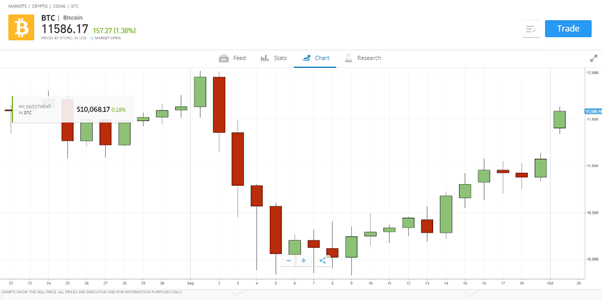Disclosure: Privacy Australia is community-supported. We may earn a commission when you buy a VPN through one of our links. Learn more.
CFDs Vs Stocks

CFDs vs. stocks. Which wins and how exactly do they stack up?
In the financial markets, there is a plethora of financial products that can be traded. Given the right conditions, each can create lucrative trading opportunities.
But in a world of wonderful choices, it is crucial to separate the wheat from the chaff. In this guide, I go through some of the main differences between stocks and CFDs.
Table of Contents:
- 🆚 Glance: CFDs Vs Stocks
- 🆚 Deeper Historical Context
- 🆚 Quick Definitions
- 🆚 Similarities & Differences
- 🆚 What Investment Should I Focus On
- 🆚 FAQs
Glance: CFDs Vs Stocks 📉
A quick disclaimer: I provide summaries of requested topics. My guides are not definitive and are not financial advice. Instead, I provide you with Mission-critical data efficiently. You will still need to do your research and consider your own circumstances. Below are some of the key characteristics of contracts for differences, and those for stocks – a quick glance.
Contracts for Differences Characteristics
- ✔️ Professional traders. They tend to be suited to traders who have a sophisticated strategy and are able to adjust to different market situations.
- ✔️ Lack of commitment. They don’t tie you to specific companies and offer the ability to jump in and out of the markets nimbly.
- ✔️ Access. They give you a vehicle that gives you access to as many markets as possible, for instance, commodities, forex, stocks, and options.
- ✔️ Dividends/ownership isn’t important. They don’t give you control of the underlying assets or pay dividends.
Stock Trading Characteristics
- ✔️ Non-professional. They tend to be suited to traders who have a basic understanding of the markets but do not actually professionally trade in them.
- ✔️ More commitment. They suit traders who have a certain affinity with the companies they invest in, and they often want to invest long-term.
- ✔️ Direct market access. They let you directly work in various markets.
- ✔️ Dividends/ownership is important. They grant you an ownership stake in a company and the ability to recieve dividends.
| CFDs | Stocks/Shares | |
| Flexible trading style | Can support any style of trading, including scalping, day trading, and swing trading. | Best suited for swing traders and investors seeking ownership of shares. |
| Characteristics | Typically involve borrowing money to make trades (taking out loans) | Shares are issued by your broker, paid for by money in your account |
| Transaction costs | Spreads/swaps | Brokerage fees |
| Leveraged product | Yes | Only available on margin accounts |
| Derivatives | Derivatives on the underlying asset | Not a derivative |
Deeper Historical Context 🏛️: Stocks vs CFDs
Context is a helpful aid when trying to understand some of the central differences between contracts for differences and stocks.
The stock market has been one of the most influential ways for businesses to raise capital and sell shares of their company. The stock market is a way to invest in companies you believe will perform well over time. It is also a speculative form of trading that has been both for the social better and worse.
And any form of trading is based on the perception of value. In order to better understand the difference between CFDs and stocks, it’s useful to look into the history of both…
1603-1700 – Origins of the Stock Market 🔔
The earliest form of the stock market was in the Dutch Republic in the 17th century.
Back then, the main financial instrument for raising money, for companies to build trading ships and other commodities, was through the sale of what were called “shares“. These shares entitled the owner to a percentage of the profits from the company, which paid in the form of dividends to the shareholders.
The first recorded example of this was in 1609, when the Dutch East India Company raised money through the sale of shares. The shares of the Dutch East India Company soared in value, making a lot of people rich very quickly.
The main reason for this was that the Dutch East India Company was building an East Indies trading empire at the time. With the company being so profitable, its stock price soared, and investors made a lot of money when they sold their shares in the company.
Ever since, the stock market has been a way to invest in companies. Investors hope their share prices will rise over time, perhaps so they can sell them at a profit. A few key events along the way:
📖 1773-1819 – The London Stock Exchange
- We need to take it back to the invention of steam engines. The LSE was officially founded in 1773 during the Industrial Revolution. The Industrial Revolution was the period of time when people began to use steam power and machines to make a lot of goods.
- The Industrial Revolution created new companies, especially in the steel industry, that were looking for investors. With so many people hoping to invest in these companies, the London Stock Exchange grew to become the world’s largest stock market.
- Up until 1819, the London Stock Exchange was an open-outcry trading floor, meaning people gathered together in one place to trade. While this was a very efficient way to buy and sell stock, it was also very chaotic and risky.
- In 1819, the LSE created the first physical trading floor for buying and selling shares. This trading floor was called the “open outcry” trading floor, and it created an orderly system for buying and selling shares.
In short, the LSE was founded at a time when London was leading the way in an industrial (productive revolution) that included the steam engine, massive productivity in steel, and mass production power.
📖 1900s-1920 – New York Stock Exchange
- Productivity increased into the wild days of the 1920s, particularly when the US experienced a boom and its own industrial revolution. In the early 1900s, people started investing in the stock market with a lot of enthusiasm. The stock market boomed and attracted a lot of investors by the 1920s.
- Notable companies like General Electric and the Ford Motor Company were listed on the New York Stock Exchange. Many people also invested in smaller companies that they believed would do well.
- The public bought stocks in massive amounts, and people began trading stocks in big numbers. The stock market by this time had become an organized and regulated system, with a centralised exchange, the New York Stock Exchange, and an established network for trading stocks.
- Stock exchanges were like a marketplace where companies could list and sell their shares for investors to buy. American banks were also heavily involved in the stock market. They would often use the money they had on hand to buy stocks, which created a system where banks were heavily invested in the market.
📖 1990s – The Origins of Contracts for Differences
CFDs, however, were born in a very different world and age.
- Rather than the natural way of participating in an intense period of productivity and physical trading of hard goods, CFDs were born as a way of hedging against volatile stocks without needing to actually own stocks.
- CFDs were developed by the British in the 1990s. Its inventors were Brian Keelan and John Wood. Both were employees of UBS Warburg, which was a multinational Swiss investment bank. Purportedly, the first transaction using this vehicle happened as part of the Trafalgar House Deal — these were used to swap equity on the margin.
- This ability wasn’t instantly offered to retail traders. Instead, it was used as a hedging feature by institutional managers and hedge funds in order to safeguard stock portfolios. They harnessed the power of marginal trading offered by CFD.
- Another advantage offered by this vehicle, at the time and up to now, is the lack of needing to own underlying assets. Because there is no purchase of shares, traders are exempt from needing to pay stamp duty in Britain.
This saw lots of traders taking advantage of the capabilities of the CFD product — everything from hedging and margins to leveraged and lack of stamp duties. Slowly, it garnered more popular attention.
Performance During Crashes: Stocks vs CFDs
Let’s look into this as a way of understanding the innate weaknesses of stocks vs CFDs…
📖 1929-1939 – Stock Market Crash
- The market crashed in 1929, lasting until 1939. This Great Depression era was a dark time for the stock market. Banks and investors went bankrupt, losing a lot of money. The stock market also lost a lot of value because companies were going out of business and their shares were worthless.
- The stock market was closed for a few years and didn’t reopen until 1934. (If you wonder if this could happen again, we’re ahead of you…that’s why Australian farmland, culture and families are such powerful investments. But more on that later.)
- When it did reopen, it was a different place than it was in the 1910s and 1920s. The Securities and Exchange Commission, or SEC, was created in 1934. The SEC is America’s regulatory agency that oversees the stock market and all the companies listed on it. The SEC has the power to investigate fraud and other illegal actions in the stock market.
📖 1984-Today – Rebuilding Confidence in the Markets
- As the markets rebounded, people began trading stocks again, and the market grew. The markets grew to become very large, with billions of dollars being traded and invested every day.
- From a low of around $6 trillion dollars in the early 1980s, the total value of all the companies listed on stock exchanges grew to more than $64 trillion dollars by 2007. However, the stock market bubble burst again in 2008 when the housing market crashed. Investors lost a lot of confidence in the stock market and didn’t feel like investing in the markets anymore.
- The markets became very cheap, and many companies were selling shares for very low prices. This created a big opportunity for investors, especially for new investors looking to get started in the markets and build their portfolios.
What Does This Mean For CFDs vs Stocks Today…?
Trading is the backbone of finance. Today, we have many of the same warning signs that a Great Depression is underway, particularly for western nations. Countries like the US, UK and Germany which were once very productive are now heavily in debt and low in resources necessary for power and electricity.
This wider context should make it clear that financial vehicles are only as strong as the economy underpinning them. With that context, let’s continue our comparison of CFDs vs stocks.
Quick Definitions 📗: CFDs vs Stocks
So What Are Stocks?
A stock is a share in a company. If you own one share in Apple Inc., you own a small piece of Apple Inc. Owners of these shares are called shareholders. When you invest in stocks, you’re betting on the company. The companies that issue stocks are called issuers. If you own a piece of a company, it’s called equity ownership or stock ownership.
So when you buy stocks, you may receive dividends, which are small slices of the company’s profits for each year. The company might be a large publicly traded company like Apple Inc. or it might be a small privately held company.
How to Buy Stocks
These days, the typical way to invest in stocks is through online brokerage accounts. Through online trading and buying and selling securities, you can quickly access market prices and place trades whenever you want. But this isn’t as easy as it sounds.
You can buy stocks via a broker, like TD Ameritrade or IG. You can also invest in stocks yourself and form your own brokerage account. This is called a self-directed account. However, because stocks can be more complicated than other types of investments, it’s best to get help from a financial advisor.
And What Are CFDs?
Meanwhile, contracts for differences are type of financial derivatives trading. There is no purchase or delivery of underlying goods or physical securities. Instead, differences between opening and closing trades are settled in cash. Because of the use of leverage, it’s considered an advanced trading strategy. You can buy/sell CFDs pretty much the same way as stocks, although there is:
- Less regulation, which has led to some scandals such as Plus500 allegedly manipulating orders in order to prevent customers from successfully claiming their profits (to a degree, providers may have a massive advantage in being able to see their hand as well as yours and to time things to their benefit)
- Lower liquidity (it may take longer to buy and sell), which can leave you stranded including fewer protections from financial insurance agencies
- The use of leverage, which amplifies the magnitude of each order – potential creating greater profits or greater losses.
Similarities & Differences 📕: CFDs vs Stocks
I’ve reviewed their histories and examined their separate characteristics. Now, let’s review CFDs vs stocks by comparing them side-by-side.
1. You Can Take Advantage of Price Movements with Both
Indeed, this is the one central similarity between the two. Both stocks and Contracts for Differences let traders take advantage of the rise and fall of underlying financial assets. Although you have to specifically short-sell so in order to take advantage of falling prices via stock trading.
2. No Pattern Day Trading Rule Applies to CFDs
Which increases flexibility. Whether you scalp, day-trade or swing deal, whatever pattern you use or length you keep your positions open, CFDs let you use them to support your investment strategy and trading style.
By comparison, stocks have more restrictions. Whether or not you can day-trade, will depend on the jurisdictions of your broker. While regulations certainly apply to CFDs as well (for instance, they are not allowed in northern America), Australians are able to avoid Pattern Day Trading (PDT) rules that would otherwise apply to a stock margin account.
3. CFDs Let You Short-sell
I mentioned this above. Because you are not purchasing the underlying asset, you are not bound directly to the equity of their assets. Whether Amazon stock falls or grows in value is not important, what matters is the direction that you bid on its movement.
By comparison, shareholders are always going long.
If a stock trader wants to short their stock, they will need to borrow shares from a broker. The trader then sells these in order to repurchase at a later date for a lower fee, in order to take advantage of the depreciating market. But be borrowing can be tricky, particularly for stocks that are thinly traded. However, there are also liquidity issues when dealing with the CFD.
“Naked shorting” is the act of selling short without initially borrowing stock, or at least making sure that it can be bought. This is illegal because it could theoretically lead to a situation where you cannot deliver.
4. Fees
CFDs will charge you a variety of transaction costs, including the spread, fixed ticket, and more. There is also a commission for accessing the market, according to your account type and broker. You can also incur overnight fees. Some of these overlap with stocks.
5. CFDs Often Use Leverage

CFDs commonly use leverage, which means that you are taking out a loan in order to trade. Only a portion of the money in the trade is your money, the rest is borrowed from your broker — that’s why it’s called trading on the margin. You’re getting exposure to the market but you put only a fraction of the full capital up.
In this instance, it is essential that you use negative balance protection features, which limit how much money you can lose to the total amount of money in your account. Otherwise, you could lose a lot more money than you actually even have in your bank account.
Many short-term traders use leverage, in order to make larger returns on small price movements.
By comparison, stock trading is divided into two types of accounts: cash accounts and margin accounts. The former lets you trade normally, only using the money that you actually have. Whereas a margin account lets you borrow cash from the broker. The broker has its own securities that it uses as collateral. Before they issue you the loan, you have to meet certain requirements, which vary according to the broker.
6. CFDs are Derivatives
Derivatives are not the same as underlying assets. When you use a CFD, you are speculating, from a distance, on the movements of these assets. Because you do not need direct market exposure to these products, using a CFD typically gives you broader access to markets, for instance, precious metals, options, commodities and stocks. But the price of your CFD is largely based on the value of their asset in the real market.
Once your contract closes, the broker and trader settle the difference in cash, minus any fees. And an investor has a profit or loss according to whether they guessed in the right direction of the price change and to what degree.
But a stock is not a derivative product. It legally represents a proportion of the publicly traded company, and shareholders own a fraction of that company. The price of your stock, therefore, directly reflects the market value of the company.
CFDs vs Stocks: What Investment Should I Focus On?
Whatever you focus on the most intensely, frequently and for the longest time period becomes your biggest point of view. How you decide to use that is up to you of course. But many signs of the times suggest that the markets are at an unprecedented point of volatility. Relying on either may not be enough to weather the storms but they can support a bigger mission.
CFDs vs Stocks 📙: FAQs
What are the Risks of CFDs vs Stocks?
Shareholders have the risk of their stock falling in price and their long-term commitment leading to a loss on investment. This is an unavoidable aspect of life and in trading.
Using a CFD has a similar amount of risk but it can be much more intense if you use leverage — there’s also a counterparty risk of the firm you are using to trade becoming bankrupt. Providers of CFDs are under less regulatory scrutiny and may have a different level of liquidity compared to direct market access of stocks.
What is the Tax Treatment of CFDs vs Stocks?
It is very possible that your CFD product incurs fewer total fees than directly trading stocks, but you will need to check according to your broker and the terms and conditions.
What is the Leverage of CFDs vs Stocks?
CFDs naturally use leverage, up to a maximum cap. This means that you are able to trade more cash than you actually have in your account. Stock trading is not leveraged unless you apply for a margin account and borrow shares.
Who are the Different Investor Types for CFDs vs Stocks?
Many investors are limited to only purchasing stocks. For instance, pension funds are restricted to stock trading rather than using a CFD. It is also prohibited in some countries like the USA.
What is the Market Coverage for CFDs vs Stocks?
In general, CFD trading can cover a much broader range of markets than stocks. This is natural because stock trading is limited to the stock market. But CFD could be used to trade all kinds of things — commodities, forex, stocks, indexes, cryptocurrencies, and more.

How does Financing differ for CFDs vs Stocks?
You will find similar administrative fees for both products, depending on your trading style certain fees will be more important than others. For instance, day traders typically want to avoid overnight fees.
Conclusion 🌞
The popularity of CFDs comes down to their flexibility. They’re nimble and noncommittal in many ways. There was a surprising history of CFDs being used by institutional investors and fund managers, in order to do hedging and equity swaps.
The CFD product is also very volatile. It requires sophistication and experience. However, holding stocks long-term can be cost-effective, with direct market access given advantages like dividends. You don’t get this with the CFD product.
While liquidity with the CFDs might be lower than trading stocks directly, with added counterparty and regulatory risks, some people use them for short-term trading — seeking to gain big returns from small price movements. This is common with scalping and day trading.
CFDs naturally let you do short-selling, which you can’t easily do with stocks. Overall, both of these products allow you to take advantage of movements in the financial markets and which one is suitable for you will depend on your trading strategy and level of experience.
You Might Also Like:





